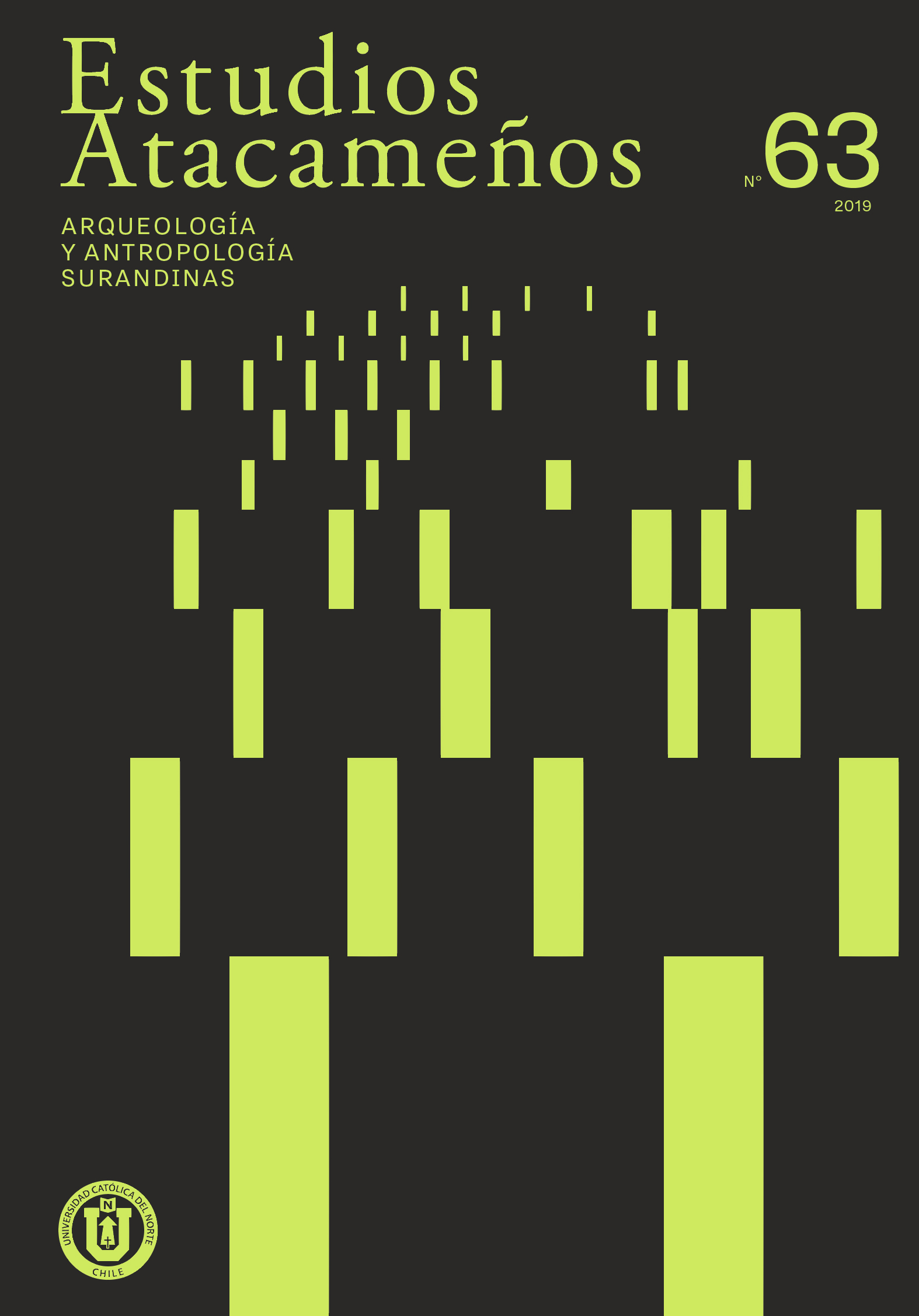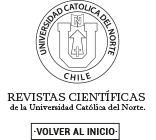Modern temples and sacred spaces:
Entangled hydrosocial territories in Cuchoquesra, Peru
DOI:
https://doi.org/10.22199/issn.0718-1043-2019-0036Keywords:
hydrosocial territories, water cultures, peasant communities, Ayacucho, PeruAbstract
This paper shows how a modern hydraulic development project interfered with local understandings of place, water, and hydrosocial territory in the Andean region of Ayacucho, Peru. Our analysis centres on two logics regarding hydraulic structures and related practices that play a crucial role in the constitution of the area’s divergent waterscapes: a large embankment dam and an “ushnu platform”. We present the practices and technologies deployed by the project engineers bringing forth a modernist hydrosocial territory connected to hydro-meteorologically measured sources, surveying and geodesic markers, dam shape and fill and seepage control. The embankment dam provides domestic and irrigation water to thousands of downstream users. Yet the dam also submerged the lived territory of the Cuchoquesera-Quispillaqta community – that is founded on water ritual practices and objects, including locally rooted notions of seepage, ushnu platform shape and fill, community markers and mountain beings protecting the wetlands. Both hydrosocial territories occupy the same space, interact and entangle in friction. This has led to changing paradigms and practices regarding (both irrigation engineering and community steered) land and water use patterning.
Downloads
References
ABA (1998). Kancha Chacra Sunqulla. La Cultura Agrocéntrica en el ayllu Quispillaqta. Lima: Asociación Bartolomé Aripaylla y Pratec.
ABA (2014). Yakumama - Madre Agua. Lagunas de lluvia y comunidades criadores del agua. Lima: Asociación Bartolomé Aripaylla.
Allen, C. (2014). Ushnus and interiority. En Inca sacred space: landscape, site and symbol in the Andes (pp. 71-77). Londres: Archetype.
Allen, C. (2015). The whole world is watching: new perspectives on Andean animism. En The Archaeology of Wak’as. Explorations of the Sacred in the Pre-Columbian Andes (pp. 23-46). Boulder, CO: University Press of Colorado.
Boelens, R. (2014). Cultural politics and the hydrosocial cycle: Water, power and identity in the Andean highlands. Geoforum, 47, 234-247.
Boelens, R. (2015). Water, power and identity. The cultural politics of water in the Andes. London: Earthscan, Routledge.
Boelens, R. y Seemann, M. (2014). Forced Engagements. Water Security and Local Rights Formalization in Yanque, Colca Valley, Peru. Human Organization, 73(1), 1-12.
Boelens, R., Hoogesteger, J., Swyngedouw, E., Vos, J. y Wester, P. (2016). Hydro-social Territories: a political ecology perspective. Water International, 41(1), 1-14.
Branch, N., Fourin, M., Kemp, R., Marini, N., Meddens, F., Onuora, C. y Silva, B. (2014). The landscape, environment and pedo-sedimentary context of Inca stepped platforms (‘ushnus’), Ayacucho Peru. En Inca sacred space: landscape, site and symbol in the Andes (pp. 99-117). Londres: Archetype.
Budds, J. e Hinojosa., L. (2012). Restructuring and rescaling water governance in mining contexts: the co-production of waterscapes in Peru. Water Alternatives, 5(1), 119-137.
Carrol, P. (2012). Water and technoscientific state formation in California. Social Studies of Science, 42(4), 489-516.
Choque, C. y Pizarro, E. (2013). Identidades, continuidades y rupturas en el culto al agua y a los cerros en Socoroma, una comunidad Andina de los altos de Arica. Estudios Atacameños. Arqueología y Antropología Surandinas, 45, 55-74.
Dean, C. (2010). A culture of stone: Inka perspectives on rock. Durham, NC: Duke University Press.
Dean, C. (2011). Inka Water Management and the Symbolic Dimensions of Display Fountains. RES, 59/60, 22-38.
De la Cadena, M. (2015). Earth Beings. Ecologies of practice across Andean worlds. Durham y Londres: Duke University Press.
Del Castillo, L. (2013). La comunidad y la irrigación de Olmos: Una relación nada justa. En Aguas robadas: despojo hídrico y movilización social (pp. 83-102). Quito y Lima: Abya-Yala – IEP.
Domínguez, C. (2013). Olmos, anhelo lambayecano: aspectos simbólicos de los grandes trasvases intercuencas y sus fines políticos. En Aguas robadas: despojo hídrico y movilización social (pp. 103-116). Quito y Lima: Abya-Yala – IEP.
Domínguez, C., Verzijl, A., Zwarteveen, M. (2017). Water footprints and ‘pozas’: Conversations between practices and knowledges of water efficiency. Water, 9(1), 16.
Duarte, B., Boelens, R. y Roa, T. (2015). Hydropower, encroachment and the repatterning of hydrosocial territory: The case of Hidrosogamoso in Colombia. Human Organization, 74(3), 243-254.
Escalante, C. y Valderrama, R. (2014). Sacred mountains and rituals in the Andes. En Inca sacred space: landscape, site and symbol in the Andes (pp. 147-156). Londres: Archetype.
Ferreira, F. (2014). ‘Ritual mixing’: an ethnographic approach to combination of fills from different origins in Inca ushnu platforms. En Inca sacred space: landscape, site and symbol in the Andes (pp. 119-126). Londres: Archetype.
Gelles, P. (2000). Water and Power in Highland Peru. New Brunswick, NJ: Rutgers University Press.
Gelles, P. (2010). Cultural Identity and Indigenous Water Rights in the Andean Highlands. En Out of the Mainstream. Water Rights, Politics and Identity (pp. 119-144) London & Washington D.C.: Earthscan.
Gerbrandy, G. y Hoogendam, P. (1998). Aguas y Acequias: Los derechos al agua y la gestion campesina de riego en los Andes bolivianos. La Paz: Plural.
Haraway, D. (1988). Situated knowledges: the science question in feminism and the privilege of partial perspective. Feminist Studies, 14(3), 575-599.
Hommes, L. y Boelens, R. (2017). Urbanizing rural waters: Rural-urban water transfers and the reconfiguration of hydrosocial territories in Lima. Political Geography, 57, 71-80.
Hommes, L., Boelens, R. y Maat, H. (2016). Contested hydro-social territories and disputed water governance: struggles and competing claims over the Ilisu Dam development in southeastern Turkey. Geoforum, 71, 9-20.
Hoogesteger, J., Boelens, R. y Baud, M. (2016). Territorial pluralism: water users’ multi-scalar struggles against state ordering in Ecuador’s highlands. Water International, 41(1), 91-106.
Huayhualla, G., Torres, L., Aperrigue, C., Morales, L. y Castro, C. (2010). Estado situacional del sistema hidráulico mayor del ex-Proyecto Especial “Rio Cachi”: Presa Cuchoquesera y Central Hidroeléctrica Catalinayocc. Informe de inspección, Ayacucho. Agosto de 2010.
Isbell, B. J. (1978). To Defend Ourselves. Ecology and ritual in an Andean village. Austin (TX): University of Texas Press.
Kuang, S. (1996). Geodetic network analysis and optimal design: Concepts and applications. Sterling, IL: Sams Publications.
Kutzner, C. (1997). Earth and rockfill dams: Principles for design and construction. Rotterdam: A.A. Balkema.
Linton, J. (2014). Modern water and its discontents: a history of hydrosocial renewal. WIREs Water, 1, 111-120.
Loftus, A. (2007). Working the socio-natural relations of the urban waterscape. International Journal of Urban and Regional Research, 31(1), 41-59.
Massey, D. 2000. Entanglements of power. Reflection. En Entanglements of power: geographies of domination/resistance (pp. 279-286). Londres: Routledge.
McEwan, C. (2014). Cognizing and marking the Andean landscape: ushnus, apachetas, sayhuas and wankas. En Inca sacred space: landscape, site and symbol in the Andes (pp. 29-47) Londres: Archetype.
Meddens, F. 2014. Boundaries at the roof of the world: the ushnu and division in political and religious space. En Inca sacred space: landscape, site and symbol in the Andes (pp. 57-70). Londres: Archetype.
Meddens, F., Branch, N.P., Vivanco, C., Riddiford, N. y Kemp, R. (2008). High Altitude Ushnu Platforms in the Department of Ayacucho Peru, Structure, Ancestors and Animating Essence. En Pre-Columbian landscapes of creation and origin (pp. 315-355). Nueva York, NY: Springer.
Ministerio de Agricultura y Riego (MINAGRI) (2016). Rumbo a un programa nacional de siembra y cosecha de agua: Aportes y reflexiones desde la práctica. Informe, Perú.
Molle, F. (2009). River-basin planning and management: The social life of a concept. Geoforum, 40(3), 484-494.
Moralejo, R. y Gobbo, D. (2015). El Qhapaq ñan como espacio de poder de la política incaica. Estudios Atacameños. Arqueología y Antropología Surandinas, 50, 131-150.
Muñoz, U. y Núñez, O. (2006). Los Kanas de Quispillaccta, historia de un pueblo quechua. Ayacucho: BRIO Informáticos e impresos.
Muñoz, U. y Núñez, O. (2007). Tesauro Kana, Ritos y Tradiciones de Quispillaccta. Ayacucho: BRIO Informáticos e impresos.
Núñez, O. (2016). Quispillacta. En La vida ya no era vida: Un homenaje a la vida y memoria de las víctimas de Allpachaka, Chiara y Quispillacta, Ayacucho-Perú (pp. 195-224). Ayacucho: Paz y Esperanza.
Ogburn, D. (2014). From Cuzco to the Four Quarters & vice-versa: connecting sacred spaces through movement of stone, sand and soil. En Inca sacred space: landscape, site and symbol in the Andes (pp. 91-98). Londres: Archetype.
Orlove, B. y Caton, S. (2010). Water sustainability: Anthropological approaches and prospects. Annual Review of Anthropology, 39, 401-415.
PERC (2005). Evaluación de las Estaciones Hidrometeorológicas e Implementación de un Sistema de Medición Hidrológica en el Proyecto Especial Río Cachi. Informe Final (tomo 1). Ayacucho: Proyecto Especial Río Cachi.
Pino, J. L. (2005). El ushnu y la organización espacial astronómica en la sierra central de Chinchasuyu. Estudios Atacameños, 29, 143-161.
Scott, J. (2006). High modernist social engineering: the case of the Tennessee Valley Authority. En Experiencing the state (pp. 3-52). Nueva York, NY: Oxford University Press.
Sharp, J. P., Routledge, P., Philo, C. y Paddison, R. (2000). Entanglements of power: geographies of domination/resistance. En Entanglements of power: geographies of domination/resistance (pp. 1-34). Londres: Routledge.
Sherbondy, J. (1982). El regadío, los lagos y los mitos de origen. Allpanchis, 17 (20), 3-32.
Sherbondy, J. (1998). Andean irrigation in history. En Searching for Equity (pp. 210-215). Assen: Van Gorcum.
Smith, J. (1997). Introduction to geodesy: The history and concepts of modern geodesy. Nueva York, NY: John Wiley & Sons.
Staler, J. (2014). Lightning (Illapa) and its manifestations: Huacas and Ushnus. En Inca sacred space: landscape, site and symbol in the Andes (pp. 177-188). Londres: Archetype.
Stensrud, A. (2015). Raining in the Andes. Disrupted seasonal and hydrological cycles. En Hastrup, K. y Hastrup, F. (Eds.). Waterworlds. Anthropology in fluid environments (75-92). Nueva York, NY: Bergham Books.
Stern, S. (1998). Shining and Other Paths: War and Society in Peru, 1980-1995. Durham (NC): Duke University Press.
Swyngedouw, E. (1999). Modernity and hybridity: Nature, regeneracionismo, and the production of the Spanish waterscape, 1890-1930. Annals of the Association of American Geographers, 89(3), 443-465.
Swyngedouw, E., y Boelens, R. (publ. prox., 2018) “...And not a single injustice remains. Hydro-territorial colonization and techno-political transformation in Spain. En Water Justice. Cambridge, MA: Cambridge University Press.
Turnbull, D. (2000). Masons, Tricksters and Cartographers. Amsterdam: Harwood Academic.
Verzijl, A. y Guerrero, S. (2013). The system nobody sees. Irrigated Wetland Management and Alpaca Herding in the Peruvian Andes. Mountain Research and Development, 33(3), 280-293.
Verzijl, A. y Domínguez, C. (2015). The powers of water-user associations. On multiplicity, fluidity and durability in the Peruvian Andes. International Journal of the Commons, 9(1), 107-128.
Williams, P. y Nash, D. (2006). Sighting the apu: a GIS analysis of Wari imperialism and the worship of mountain peaks. World Archaeology, 38(3), 455-468.
Zuidema, T. (2008). The astronomical significance of ritual movements in the Calendar of Cuzco. En Pre-Columbian landscapes of creation and origin (pp. 249-268). Nueva York, NY: Springer.
Zuidema, T. (2014). The ushnus of Cusco and sacred centres in Andean ethnography, ethnohistory and archaeology. En Inca sacred space: landscape, site and symbol in the Andes (pp. 5-28). Londres: Archetype.
Downloads
Published
Issue
Section
License

All works published in Revista Estudios Atacameños (ISSN on line:0718-1043) Revista Estudios Atacameños Creative Commons International 4.0 attribution (CC BY 4.0) licence.
Authors remain the owners of their work and may republish their articles elsewhere without having to request permission, as long as they indicate that the work was originally published in Revista Estudios Atacameños (ISSN on liine:0718-1043).












